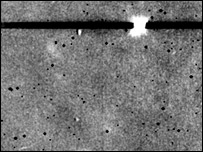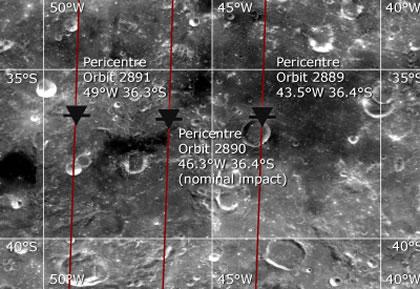Spectators in Hawaii caught the moment of impact

“>
The European spacecraft SMART-1 ended its life this morning by crashing on the surface of the moon. It was a spectacular end for the robotic spacecraft that has spent the past 16 months testing innovative miniaturized space technologies.
SMART-1 provided detailed maps of the chemical composition of the moon's surface, which will help update theories about the moon's birth. The event, which was observed through telescopes by amateurs and professionals alike, crashed at exactly the appointed time - 05:43 GMT, 08:43 Israel time, this morning (A).
The spacecraft crashed on the side closest to us, in the middle southern latitudes, in the area known as the "Lake of Excellence".

The spacecraft hit the lunar surface at a speed of about 7,200 km/h, a violent enough impact that it could be observed from Earth. According to the exaggerated design, at the time of the collision, the telescopes were supposed to see fresh lunar dust being pushed up, as well as a heat flash, which originated from the melting of part of the spacecraft's structure by volatile materials left on it.

Pictured: Always illuminated areas on the moon
"Smart-1 will end its life for sure, and as its "father" I must admit that I feel a little sad," said Prof. Bernard Poing, the chief scientist of the project on behalf of the European Space Agency. "But she will live on, in the sense that we will continue her tradition and analyze the scientific data she collected, and continue the experiments in future missions." added
A fleet of spacecraft - both orbiters and landers - are expected to visit the moon in the coming years. This train, which for now consists only of unmanned vehicle units, will reach its peak when humans return to the lunar soil, for the first time since the Apollo missions, which will happen in about 2020.
Smart-1 was launched in September 2003 as a technology demonstration spacecraft. She became the first European spacecraft to be powered by an ion engine instead of a chemical propulsion engine. The electrical power was obtained through solar collectors, and these were able to propel the spacecraft forward by repelling xenon particles. The engine was extremely efficient, and the spaceship circled the Earth numerous times, covering 100 million kilometers, in a series of looping orbits, consuming only 60 liters of "fuel".
"It's remarkable - when you think about it - with the same volume of fuel that you put in a car, we managed to get all the way to the moon," said Prof. Manuel Grande from the University of Wales in Aberystwyth.
Ion engines will be used by most of the next spacecraft that Europe will launch, such as BepiColumbo to Mercury. Prof. Gardena himself was the principal investigator responsible for the miniaturized instruments of SMART-1: the compact X-ray spectrometer known as D-CIXS. This device mapped the composition of the moon and mainly examined the distribution of calcium, magnesium, ferrous aluminum and iron.
Knowing and evaluating these elements will help update the theories about the creation of the moon, according to which the moon was formed from the amalgamation of fragments thrown from the earth in a huge collision between the earth and a body the size of Mars, billions of years ago.
"Like everything else on this spacecraft, our X-ray technology was smarter, smaller and lighter than anything previously flown," said Prof Grande. The device weighed about 5 kg. Similar devices used for similar tasks in the past weighed 10 times more.
The success of the D-CIXS was so great that an improved version of it known as CIXS is currently being built and will be mounted on the Indian Chandrayaan spacecraft that will fly to the moon in 2007 or 2008.
The Smart-1 AMIE camera also added to the understanding of the moon. The best digital maps of the moon, so far, came from the American spacecraft Clementine, with a resolution of 200 meters. At its peak, Smart-1 revealed formations 40 meters in diameter. Although this resolution is not sufficient to locate individual remnants of the equipment left by Apollo, the data can be used as a comparison tool in the study of the images taken by the pioneering astronauts. "For example, we were able to match the Smart-1 data with those taken from the ground by Apollo 15 crew members. The images consistently match the panoramic images taken by the astronauts," said Prof. Fong, adding: "Therefore, I believe they were indeed there."
Among the landmarks of the operation it is worth noting that Smart-1 found mountain tops in the North Pole region that are always in the sunlight. She also looked for low-lying areas that are in perpetual darkness, where ice might exist. "Both types of areas can be extremely useful for manned missions, the first for placing a power plant that will be powered by solar energy and the second - as a source of water."
"Smart-1 will now rest safely on the moon," said Prof. Poing. "Now, we are cooperating with the international community, preparing the way for future research of the moon - a fleet of satellites, landers that will lead to the establishment of robotic villages and manned bases."
Drafting and editing: H. J. Glykasm, translations and technical writing
The achievements of Smart-1

* Mini-devices, software for navigating and operating the spacecraft will be used in future operations in the solar system.
* Motors powered by the sun and electricity will become the dominant drive systems.
* The data improved our knowledge of the moon, the history of its impact and volcanic activity, assistance in locating good landing sites.
to the video on the BBC website explaining the crash process
Smart-1 will crash on the moon tonight or tomorrow morning (one out of three chances)
2.9.2006
By: Avi Blizovsky

The European spacecraft Smart-1 orbiting the moon is set to crash into its surface on September 2 or 3, when observers with ground-based telescopes will be able to see the crash.
The spacecraft will crash into the Lake of Excellence, an area with interesting mineralogy, right on the edge of the far side of the moon and on the border between day and night. This time allows the scientists to get a contrast thanks to which it will be possible to see the crash, when the fragments of dust that will be blown up during it will be illuminated by the sunlight and will also reflect the light coming from the Earth.
The time chosen is Sunday at 05:41 GMT (08:41 Israel time), and the best place to watch it will be from telescopes in South America and the North West of the USA, Hawaii and Australia. However, there is a fear that the spaceship will crash on a mountainside in one of the previous laps. For example, it could crash at 00:37 GMT (03:07 Israel time), then it would be possible to watch it from the Canary Islands and South America, or even earlier, on September 2nd at 19:33, then it would be possible to watch the crash from Europe, Africa and the Middle East.
Since the speed of the crash will be about 2 kilometers per second, Smart-1 will open a crater with a diameter of 5-10 meters and a depth of about one meter - about a crater that creates a meteorite weighing two kilograms. Powerful telescopes on Earth may see a faint flash from the impact itself, followed by a 5 kilometer diameter cloud of dust blown up by the collision.
Amateur astronomers around the world volunteered to watch the explosion, to examine the properties of the minerals below the surface. However, if the dust cloud stretches to a distance of more than 20 kilometers towards the illuminated area of the moon, enthusiasts will be able to follow the cloud using binoculars or small telescopes.

2 תגובות
I love the spaceship interview